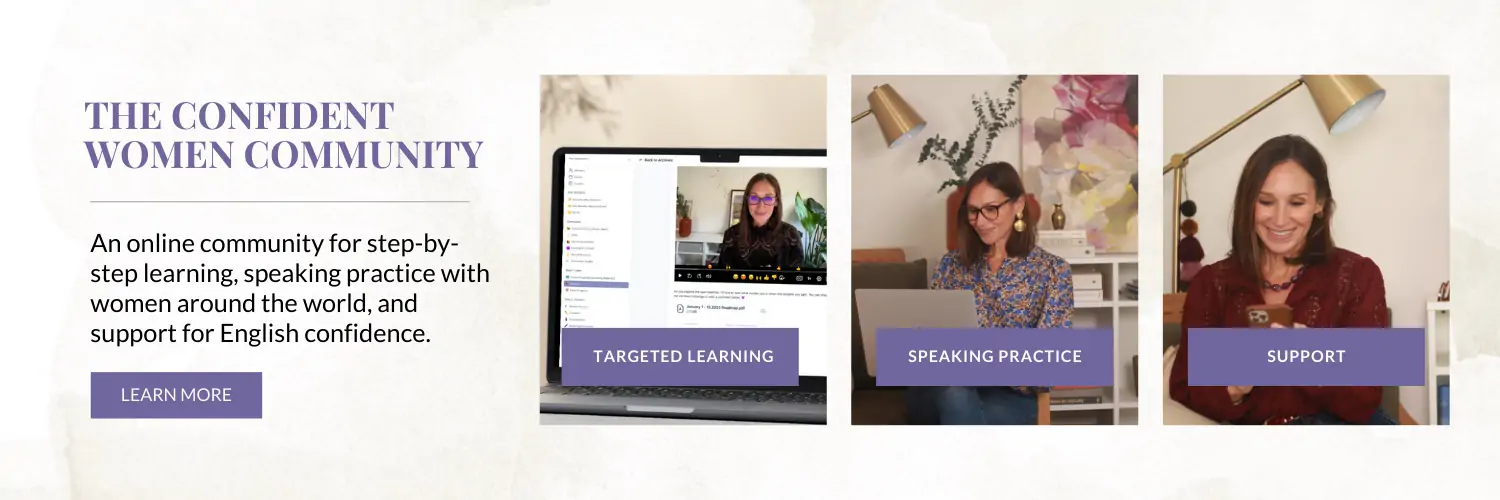#262: 4 Steps to Find Flow & Enjoy Your English Practice

When do you feel most happy?
Your first thought might be: “It’s when I’m doing nothing. Just relaxing.”
Perhaps that’s true.
Or is it when your brain is fully engaged? When you’re doing something with such focus you lose track of time?
You look at the clock and think, “Wow! What happened to the time?”
For example, working out a new song on the piano. Solving a problem. Completing a crossword puzzle. Creating website graphics. Calculating your travel budget. Painting.
This feeling of getting lost in an activity? This is what we call flow state. Also known as getting into the zone.
According to positive psychology, you’re in flow when you are absorbed in an activity. You have a feeling of energized focus, complete involvement, and enjoyment of the process.
And it’s when we’re at our happiest.
We can thank psychologist Mihály Csíkszentmihályi for the flow state theory. Based on his research
“The best moments in our lives are not the passive, receptive, relaxing times… The best moments usually occur if a person’s body or mind is stretched to its limits in a voluntary effort to accomplish something difficult and worthwhile.” — Mihály Csíkszentmihályi
So how does this relate to your English learning?
How often have you set goals to practice English 4 times per week? Or to become more fluent before the of the year?
How often do you lose track of your goals? Feel too frustrated or stressed or bored or tired to practice?
How often do you think, “I know I SHOULD study English right now. But I don’t want to.”
Are you raising your hand right now?
I get it. I’ve been there too.
Is there a way to use this flow state theory to enjoy your English learning practice?
Can you have fun learning and make progress in your English?
You can.
In this lesson, you’ll get 4 practical steps to find flow so you enjoy your English learning practice.
You’ll also get key English vocabulary for talking about flow state.
As with meditating, creating art, or problem-solving, you can find flow in learning.
It’s when you are totally, happily immersed in what you’re studying.
WATCH THE LESSON
4 Steps to Find Flow and Enjoy Your English Language Practice
Step 1: Identify Your Golden Hour(s)
A golden hour is also known as the magical hour which is the perfect time to capture a photo in soft light.
In the same way, your golden hour(s) are the peak times your mind is ready to learn, analyze, and process information. It is also the time when you feel the most focused and the least distracted.
To find your golden hour, assess your weekly routine. Then identify the times when you feel most energized and/or open to discovery.
Step 2: Set the Right Tone & Get in the Mood
ONE: Remove All Distractions
Noise. Hunger. Email pings and social media alerts.
These are all potential distractions. And distractions get in the way of flow.
To remove distractions, follow these tips:
- Find a study place that is quiet, peaceful, and distraction-free.
- Remove clutter from your surroundings. This contributes to qualities of peace, quiet, and clear focus.
- For instance, if you have your to-do list on your table, put it away. If your phone is on your desk, move it. Or turn it off.
- Organize papers into a neat pile and schedule time later to file them away or get rid of them.
TWO: Create A Pre-Flow Ritual
The next step is to create a pre-study or pre-flow ritual.
A pre-flow ritual is a series of actions that will stop mental chatter and tell your brain it’s time to study.
Journaling is an ideal way to remove thoughts of anxiety, frustration, or demotivation.
And meditation is a fantastic way to become more attuned to the present moment.
Some individuals prefer complete silence while in flow. Others find a playlist of instrumental or ambient music can help you focus.
I definitely prefer to have music when I’m creating, problem-solving, and writing. And I have several playlists I recommend.
Step 3: Focus on One Task That Is Challenging, But Not Too Challenging
Without a clear plan of what to focus on, flow state isn’t possible. Plus, you might switch from one task to another too quickly.
The solution is to focus on one clear task. In other words, avoid multitasking.
That means you need to have clear goals for your learning. And a plan of what to study, so you can dive into your flow state without wasting time.
A study plan could include a list of possible tasks. Each one should help you improve your skills and be challenging at the appropriate level.
This means it should engage your brain and feel like a challenge. But not so challenging that you feel frustrated or stressed.
Step 4: Do What You Enjoy (But Don’t Force It)
This is crucial. When you want to enter a flow student in your learning practice, choose tasks you enjoy. Do the things you love to do. Not the things you have to do (save those for another time).
Everyone will find flow in a different way. So it’s important to choose the study tasks that intrigue and engage you.
It should make you feel good about doing it.
When your practice feels stagnant or when you feel distracted, remember that it’s ok to reset.
Or simply try another day. Don’t force it. If you don’t enter that flow state on a particular day, that’s okay. It’s not a failure.
Take a moment to write down your thoughts of frustration. This helps to relieve that negative energy. And then switch your focus.
You can still study, learn, and make progress by completing small tasks. Even if you’re not in flow.
You can also reorganize and refresh your practice. To do this, allow your intention to inform your choices.
Write your intention on a Post-It note and stick it where you will always see it.
This will give you a daily reminder of your intention and help you stay on your path.
To realign with your intention, consider the following questions:
- Why do I want to improve my [insert the specific skill you want to improve]?
- How will strengthening my English skills improve my life?
- What can I do to make my practice intriguing and enjoyable?
- Which activities are no longer interesting or challenging?
Now that you have 4 steps to help you enjoy your English learning practice in a flow state, I have two questions for you:
Question 1: What activities have helped you enter a flow state?
If you’re not sure, think about activities you’ve enjoyed in English. Activities that made you feel accomplished.
Question 2: After today’s lesson, what is your next step? Which of the steps from today’s lesson will help you refresh your English practice?
You can share your answers — as well as your questions — with me in the comments below.
~ Annemarie

Get the Confidence to Say What You Want in English
Follow my 3-step solution to speak English with clarity, fluency, and freedom so you can say what you want with confidence.
You'll also get my Confident English lessons delivered by email every Wednesday and occasional information about available courses. You can unsubscribe any time.
More Like This
Learn English Phrasal Verbs Faster — 5 Minute Routine
Tired of forgetting English phrasal verbs the moment you need them? In this Confident English lesson, you’ll learn a 5-minute daily routine to make phrasal verbs stick—so you can remember them, use them naturally in real conversations, and finally stop second-guessing. Whether you need phrasal verbs for work, everyday conversations, or English speaking practice, this lesson gives you practical steps that fit your real life.
Sound Fluent & Professional: English Phrases for Meetings & Updates
Want to speak English more naturally at work? In this lesson, you’ll learn powerful English phrases for meetings and updates, including business phrasal verbs professionals use every day. Get the vocabulary and expressions you need to give confident project updates, explain delays clearly, and wrap up your message like a pro.
How to Give a Project Update in English at Work
Give a clear project update in English with a concise 3‑step framework. Get the phrases and structure to deliver professional project status reports confidently at work.
Professional Ways to Ask for Help in English (4-Step Formula)
Learn how to ask for help in English at work—without sounding unsure or unprepared. This 4-step formula gives you clear, professional phrases for meetings, emails, and team collaboration.
30+ English Phrases to Compliment Food Naturally and Politely
Learn 30+ natural English phrases for food and how to compliment food in English politely and sincerely. Perfect for dinner parties, eating out, and everyday English conversations.
Describe Food in English: The Ultimate List of Taste & Texture Vocabulary
Learn how to describe food in English with confident, natural vocabulary. Get taste and texture adjectives English speakers use in real conversations, from restaurants to everyday life.
© Copyright 2014-2025 Speak Confident English | Privacy Policy | Terms & Disclaimer | Online Class Policies






just discovered the great training. have learn a lot and looking forward to a positive change
Hi Annemarie,
Thanks a lot for your very useful lesson. Handlettering is the best way to create a Pre-Flow Ritual for me. During this activity I tell my brain it’s time to study. Sometimes I meditate and it helps me too. After today’s lesson my focus will be on remove all distractions from my surroundings. I need to work on my concentration. It’s really so difficult for me and it’s my resolution.
Greetings
Learnt the steps and formula to be in flow. Each and every step is important to be in flow. What an amazing technique. I need to apply these techniques in my personal and professional job to be more productive and enjoy more. Thank you Anne Marie.
Hi Annemarie,
I enjoy listening and watching English Podcasts whose subject I am interested in like science.
I am an early bird person, so I set a plan to listen to the one of English medical podcasts in a quiet place after removing external distractions, then writing down new words which I don’t know. After it ends, I search the new words meaning, writing its most important things briefly, then try to rephrase some points of the Podcast to get flow in it.
Thank you for your most useful strategies to enter the flow state.
Hi Annemarie!
Thanks a lot for helping us in getting flow and fluency in the English speaking journey.
The activities I enjoy are——-
Quizes, listening stories, watching short movies or serials and reading practice.
After today’s lesson my focus will be on the challenging task that is speaking practice. I have to do it alone. Really its very difficult and challenging for me.
Thanks
Thank you for motivating us. What should I do if English learning is not so funny for me? :-(. I try to practice to improve my comprehension, listening and speaking skills but I quickly get bored.
But, after this video i will write down the purpose or the intention why I need to improve my English, which is to get a promotion at work.
Hi Merry, thanks for the question. I would reflect on other skills you have learned and what you enjoyed about the process. From there, you may be able to determine which activities you will enjoy for your English practice. It’s also important to select activities that are the appropriate level of challenge so you avoid boredom.
Dear Anne-Marie,
Thank You for every knowledge you provided me with.
The best activities I enjoy are:
cross words
grammar quiz
and
audibles Books
I’m glad you’ve identified activities you enjoy. These are great options when you want to get in the flow.